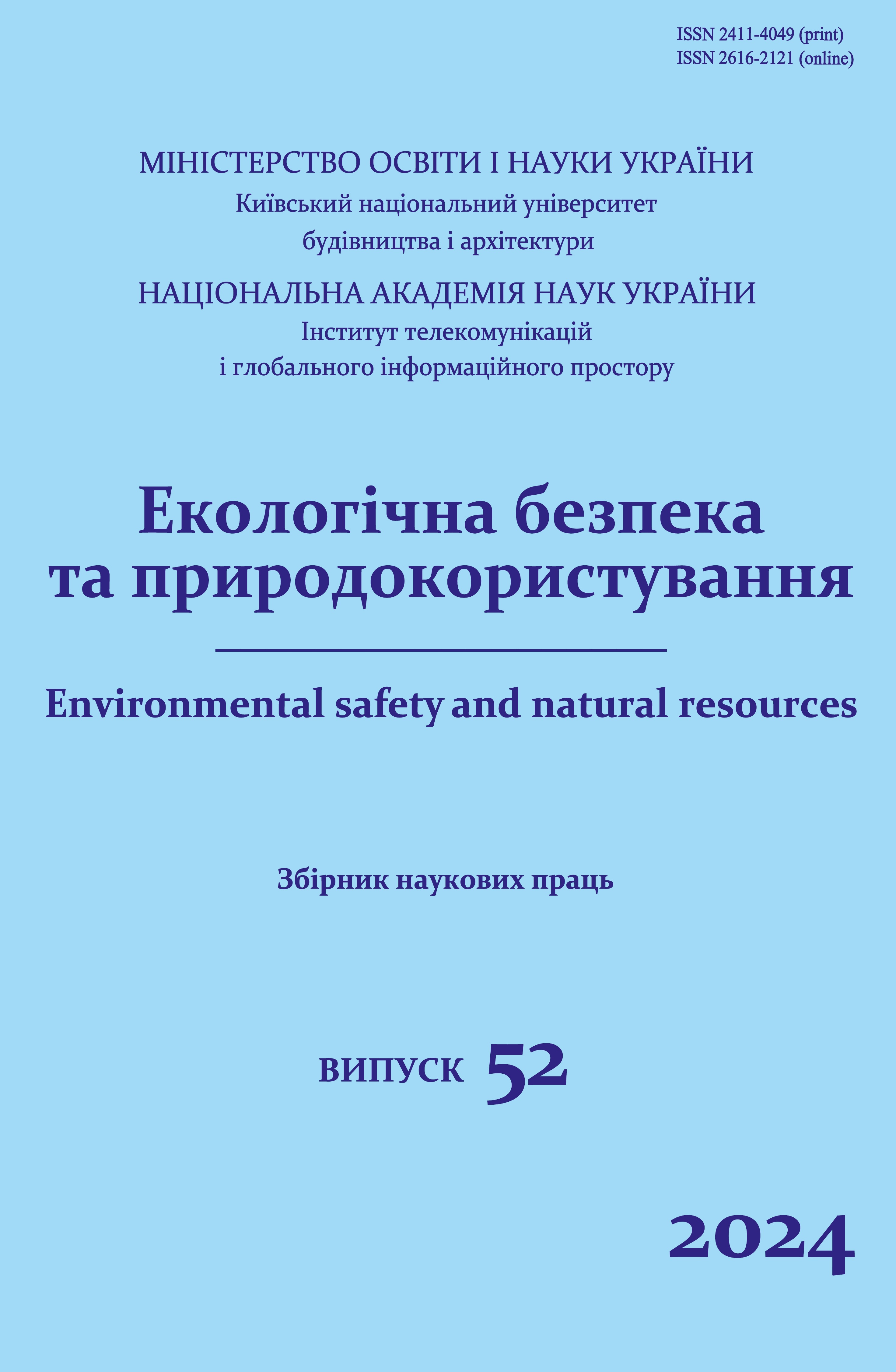Determination of climate risks in the construction industry against military actions
DOI:
https://doi.org/10.32347/2411-4049.2024.4.45-52Keywords:
climate risk, greenhouse gas emissions, construction industry, military operationsAbstract
The post-war reconstruction of Ukraine requires the introduction of low-carbon technologies in the construction sector and adaptation measures to climate change, taking into account greenhouse gas emissions caused by military actions in Ukraine. In this study, based on existing domestic and global regulatory documents on determining climate risks, chains of influence on climate risk are presented within the framework of assessing climatic factors that affect the calculated energy consumption data of a building at the project stage in the winter and summer periods. Preliminary calculations of the dynamics of changes in energy consumption for heating in the winter period for the city of Kyiv showed a decrease in energy consumption in two winter months by almost 16%, starting from 1942 for a conventional panel house with a wall area of 200 m2. While energy consumption for cooling in the hot period has been gradually increasing over the last decade. The forecast dynamics of the average monthly temperature according to the usual and wet bulb thermometer in July in 2050 is 26.371⁰С and 28.918⁰С, respectively. Modeling the dynamics of temperature increase for the city of Kyiv was carried out on the basis of climate databases: ECA&, Copernicus and the Central Geophysical Observatory named after B. Sreznevsky, as well as assessment reports on global climate change. The category of intermediate impacts included the impact of military actions on the urban environment and population, such as: an increase in the heat dome over the urbanized area, an increase in the heat index for public health, an increase in atmospheric air pollution. Possible adaptation measures should be taken depending on the specific reconstruction project throughout the life cycle of the facility, taking into account innovative low-carbon technologies, including the production of building materials. These studies may be promising in the future for finding ways to compensate for the mitigation of climate damage caused by Russia's military actions and neutralize this impact in modern buildings and structures.
References
Stepanenko, S.M., & Polyovoy, A.M. (2018). Climatic risks of the functioning of sectors of the economy of Ukraine in the context of climate change: monograph. ODEKU. Odesa: TES [in Ukrainian].
Watkiss, P. and Betts, R.A. (2021). Method. In: The Third UK Climate Change Risk Assessment Technical Report [Betts, R.A., Haward, A.B. and Pearson, K.V. (eds.)]. Prepared for the Climate Change Committee, London.
Climate risk report for the Middle East and North Africa (MENA) region. (2021). MetOffice/Hadley Centre.
DSTU EN ISO 14091:2022 Climate Change Adaptation: Guidelines for Vulnerability, Impact and Risk Assessment (EN ISO 14091:2021, IDT; ISO 14091:2021, IDT).
AR 6, IPCC. (2021). Adaptation to climate change. Guidelines on vulnerability, impacts and risk assessment.
DSTU ISO 31000:2018 Risk Management: Principles and Guidelines (ISO 31000:2018, IDT).
Stepanenko, S.M., Voloshkina, O.S., Malovany, M.S., & Kovaleva, A.V. (2024). The need to take into account global climate change when calculating the energy efficiency class of buildings. In V International Scientific and Practical Conference “Energy-saving machines and technologies”, May 22-24, 2024, KNUBA (pp. 199-202) [in Ukrainian]. http://esmt.knuba.edu.ua/wp-content/uploads/2024/09/ESMT-2024-Conference-proceedings.pdf
Climatic database of the B. Sreznevsky. Central Geophysical Observatory. Retrieved from http://cgo-sreznevskyi.kyiv.ua/uk/diialnist/
Climate Data Store – ERA5 explorer. Climate Change Service Copernicus. Retrieved from https://cds.climate.copernicus.eu/apps/c3s/app-era5-explorer
List of international climate indicators. Retrieved from https://climate-adapt.eea.europa.eu/en/knowledge/europeanclimate-data-explorer/overview-list
Estada, F., Gay, C., & Conde, C. (2012). A methodology for the risk assessment of climate variability and change under uncertainty. A case study: coffee production in Veracruz, Mexico. Clim. Change, 113: 455-479. https://www.doi.org/10.1007/s10584-011-0353-9
Methodological approach considering different factors influencing vulnerability. (2015). Pan-European scale. DROUGHT-R&SPI, Tech.Report No 26.
Papathoma-Kohle, M., Promper, C., & Glad, T. (2016). A Common Methodology for Risk Assessment and Mapping of Climate Change Related Hazards – Implications for Climate Change Adaptation Policies. Climate, 4, 8. https://www.doi.org/10.3390/cli4010008
Kona, A., Bertoldi, P. et al. (2018). Guidance «How to develop a Sustainable Energy and Climate Action Plan in the Eastern Partnership countries». European Commission, Joint Research Centre of the Covenant of Mayors for Climate and Energy 113659. Retrieved from https://joint-research-centre.ec.europa.eu/index_en
Masum, J.H. (2019). Climate Change Risk Assessment: Exploring the current state of knowledge to assess climate change risks from local to national level. Coastal Development Partnership (CDP), Bangladesh. ISBN: 978-984-34-7046-1
Methodological recommendations for assessing risks and vulnerability of socio-economic sectors and natural components to climate change (2023). Order of the Ministry of Environmental Protection and Natural Resources of Ukraine dated 03.06.2023. No. 386. Retrieved from https://mepr.gov.ua/wp-content/uploads/2023/06/386nd1.pdf
The Climate Impact of the Russian War in Ukraine. February 24, 2022 – September 1, 2023. Greenhouse Gas Emissions Accounting Initiative. Report supported by the European Climate Fund (ECF) and the Environmental Policy and Advocacy Initiative in Ukraine (EPAIU). https://ecoaction.org.ua/wp-content/uploads/2024/01/Report-2023_December_UA_compressed.pdf
Low-carbon warfare: climate change, net zero and military operations. Retrieved from https://academic.oup.com/ia/article/99/2/667/7024982
Climate Impact of the Russian War in Ukraine, First Interim Assessment. In English: https://en.ecoaction.org.ua/climate-damage-caused-by-russias-war.html. In Ukrainian: https://ecoaction.org.ua/vplyv-ros-vijny-na-klimat.html
Climate Impact of the Russian War in Ukraine, Second Interim Assessment. In English: https://en.ecoaction.org.ua/climate-damage-by-russia-12-months.html. In Ukrainian: https://ecoaction.org.ua/vplyv-ros-vijny-na-klimat-2.html
The Vulnerability Sourcebook – Concept and guidelines for standardised vulnerability assessments. (2014). GIZ, adelphi, EURAC. Eppelheim.
Downloads
Published
How to Cite
Issue
Section
License
Copyright (c) 2024 A.V. Goncharenko

This work is licensed under a Creative Commons Attribution 4.0 International License.
The journal «Environmental safety and natural resources» works under Creative Commons Attribution 4.0 International (CC BY 4.0).
The licensing policy is compatible with the overwhelming majority of open access and archiving policies.

